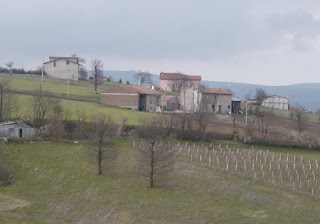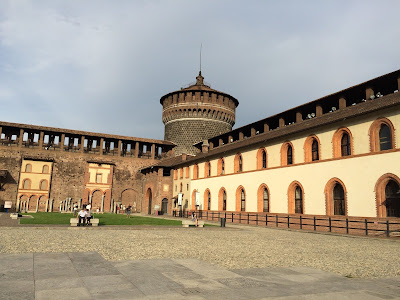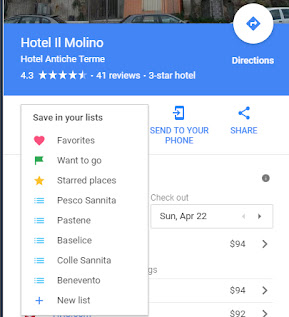The further back you go in your family history, the more branches you have to explore. And if you have a lot of branches, you probably have a bunch that need more research work.
At some point, your research may toss some new facts at you that make you realize the sad truth. You've got a big old mistake in your family tree.
What will you do when that happens?
How a Mistake Can Pop Up
 |
| I realized I'd swapped Rubina for Rufina when I found her married to the wrong man. |
Let me give you a concrete example using one of my 16 third great grandmothers. (We're all entitled to 16 third great grandmothers and 16 third great grandfathers.)
One year ago I discovered that my 2nd great grandmother was born in the little town of Santa Paolina, Italy. I learned this important piece of information when I found the marriage records of 2 of her brothers.
Those records (from a neighboring town) said my 3rd great grandparents lived in Santa Paolina.
So I ordered a few films for Santa Paolina. This was days before the end of the FamilySearch microfilm program. Everything was going online. But at the time, the vital records for Santa Paolina's province were not online. And I didn't want to wait.
I spent a few hours going through the dark and fuzzy document images and found some pay dirt. I found my 2nd great grandparents' Santa Paolina marriage record. That led to my 2nd great grandmother's birth record and that of her first baby.
I found that my 3rd great grandfather's name was different on each document. He was:
- First name: Semblicio or Simblicio
- Middle name: Fiorintino or Fiorentino or Fiorinto or Florindo
- Last name: Consolazio
The first name makes sense because of my 2nd great uncle (his grandson) Semplicio. But I made a note that this man sometimes goes by a variation of Fiorintino.
There was more confusion with my 3rd great grandmother's name. It was Rufina Zullo, but I didn't see anyone else named Zullo in Santa Paolina. I saw Zuzolo and Cenzullo. When I found a Rubina Cenzullo, I started to think this was a spelling variation of Rufina Zullo. Eventually I convinced myself Cenzullo = Zullo.
Now the Santa Paolina and Tufo documents are available online. I downloaded all the Santa Paolina records to my computer, and a few select years of Tufo records. (See "How to Use the Online Italian Genealogy Archives".) This past weekend I was going through the downloaded vital records for more facts and people.
My 3rd great grandparents' marriage record wasn't there. I began searching every logical year for it. When I didn't find it, I thought, "What if they married after their first child was born?"
That's when I found something that made me gasp. In 1844, after the first baby was born, I found a marriage record for Rubina Cenzullo…to another man! But she kept having babies with Simblicio Consolazio!
At that moment I realized she wasn't my 3rd great grandmother. I returned to my 2nd great grandmother's birth record and that of her sister Catarina. Both documents said their mother was Rufina Zullo. I'd gone off in the wrong direction!
Working to Fix the Error
How would I find the right woman? I searched every logical year of birth records and found no one in town named Zullo. So I had to find her death record.
I know she had a baby in 1856, so I started there. I search the death indexes of each year looking for Rufina Zullo or Simblicio Consolazio. I found Simblicio's death record in 1891. Rufina was still alive, so I kept searching.
I finally found her death record in 1898, and with it, the answer to the mystery. Rufina Zullo was born in another town called Apice—a new ancestral hometown for me!
Luckily, the Apice vital records are online. I found the real Rufina's 1816 birth record, so now I had the names of my real 4th great grandparents. Then I found Rufina's 1843 marriage to my 3rd great grandfather, named as Fiorintino.
Since they married in Apice, there should be marriage banns recorded in his hometown of Santa Paolina, too. And there are! I'd overlooked them because I'd checked only the index for 1843. They didn't marry there, so they aren't in the index.
Learning from Mistakes
Here are the specific lessons I learned:
- Don't make assumptions without a lot of evidence to support them. Some document convinced me her last name was Cenzullo. But there was so much evidence saying it was Zullo. I don't know what I was thinking.

Detaching a person from the wrong
family in Family Tree Maker. - Search for all the major documents for your person and their immediate family. Notice when the facts on some documents contradict the facts on others. Then search for what's missing. Finding Simblicio's death record confirmed Rufina's name. Finding Rufina's death record confirmed why she was the only Zullo in town.
- Look beyond the indexes. They are a tremendous help, but there are times when you won't find the document you want in the index—especially when it comes to marriages.
Now I had to fix this problem in my family tree. I had Rubina Cenzullo as the wife of Semblicio and the mother of his 8 children. I also had her parents, 2 grandparents and 2 siblings. In Family Tree Maker I selected Rubina. In the Person menu, I choose Attach/Detach Person and Detach Selected Person. I clicked the checkbox for Semblicio and the 8 kids and clicked OK.
Next I attached my No Relationship Established image to Rubina and her people. I'm hold onto them for now because Santa Paolina is so very small. There may be a relationship to her.
Finally, I added my Rufina as the wife of Simblicio and mother of his kids. I attached her parents to her.
At last! My great great grandmother's family is complete.
 |
| My Consolazio family, complete with the right mamma. |
And speaking of fixing family tree boo-boos:



























